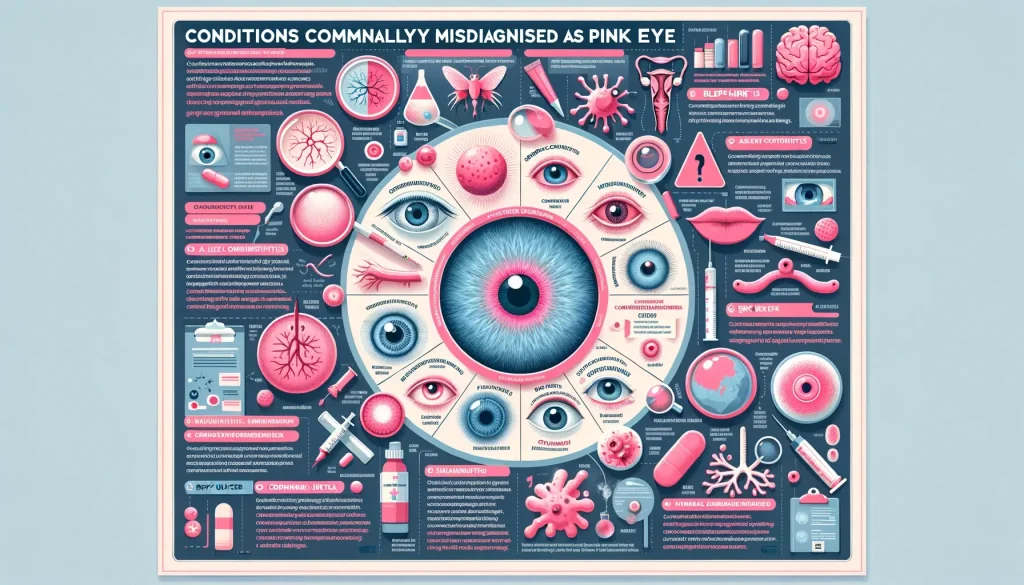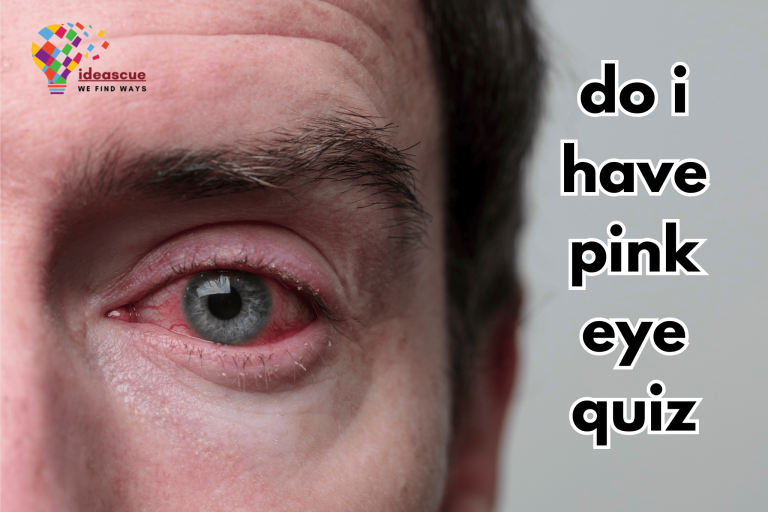What is Commonly Misdiagnosed as Pink Eye – Pink or Dry Eye?
Intro:
Pink eye, commonly known as conjunctivitis, is a widespread eye condition. However, many other conditions mimic its symptoms, leading to frequent misdiagnosis. This article dives into the details of pink eye and its look-alikes to debunk what is commonly misdiagnosed as pink eye.

What is Pink Eye Condition?
Pink eye or conjunctivitis is an inflammation of the conjunctiva, the clear tissue covering the white part of the eye.
This condition may stem from a range of factors, such as infectious agents, allergies, or contact with hazardous substances.
Is It Pink Eye, Dry Eye or Something Else?
Pink eye or conjunctivitis causes redness and discharge in the eye due to inflammation. Dry eye occurs when your eyes don’t produce enough tears or when tears evaporate too quickly, causing burning and blurred vision.
Type of Conjunctivitis:
Conjunctivitis, commonly known as pink eye, manifests in various forms. Bacterial conjunctivitis results from bacterial infections and often produces a yellow-green discharge.
Allergens can provoke symptoms of itching and redness in what is known as allergic conjunctivitis.
Meanwhile, chemical conjunctivitis arises from exposure to irritants like chlorine, causing redness and a burning sensation.
Below, the types of eye infections, allergies, and diseases are explained in detail:
Bacterial Conjunctivitis:
Bacterial conjunctivitis, often called pink eye, occurs when bacteria infect the eye. It often leads to redness, swelling, and a yellow-green discharge. Without treatment, it can last several days to weeks. Prompt medical attention ensures a faster recovery.
Viral Conjunctivitis:
Viral Conjunctivitis, often mistaken for bacterial pink eye, viral conjunctivitis exhibits similar redness and watering. However, it often accompanies cold or respiratory symptoms and lacks the thick discharge of bacterial forms.
Allergic:
Allergic conjunctivitis is triggered by allergens such as pollen or pet dander. It leads to itchy, red, and watery eyes. Unlike bacterial or viral forms, it’s not contagious.
Chemical:
Chemical conjunctivitis occurs when irritants, such as chlorine or household cleaners, come into contact with the eyes. This results in redness, burning, and a gritty sensation. Immediate rinsing and medical consultation can mitigate complications.
Pink Eye Symptoms:
Pink eye, or conjunctivitis, primarily presents with a noticeable red eye or pink hue in the affected eye. Patients often experience itching, tearing, and sometimes a discharge that can be clear or colored. Other symptoms can include:
- Redness: The most common symptom causing a pink or red coloration in the eye.
- Itching: An irritating sensation prompting a desire to rub the eye.
- Tearing: Excessive production of tears, leading to watery eyes.
- Discharge: Varies from watery to thick and can be clear, white, yellow, or green.
- Sensitivity to Light & Blurry Vision: A discomfort when exposed to light and unclear vision.
- Swelling: Puffiness around the eyes, particularly the eyelids.
Take an eye exam and see if your eyes have similar symptoms as above.

How to Prevent Pink Eye:
Preventing ailments, in general, is crucial as it saves time, reduces discomfort, and prevents potential complications. Especially with pink eye, prevention can minimize the spread and impact of the infection. Here are some eye care routines and what you can do to prevent pink eye:
- Wash hands frequently with soap and water.
- Ensure you do not come into contact with or touch your eyes.
- Never share personal items like towels or makeup.
- Replace makeup products regularly, especially eye cosmetics.
- Wear protective eyewear when exposed to irritants or chemicals.
- Maintain the cleanliness of your pillowcase by replacing it with a fresh one on a consistent basis.
- Avoid close contact with individuals with active pink eye infections.
- If you wear contacts, ensure proper cleaning and handling.
- Stay away from known allergens if allergic conjunctivitis is a concern.
- Ensure swimming pools you frequent are well-maintained to reduce chemical irritants.
- Try an eye checkup once a month. The doctors may suggest eye drops that will prevent viral pink eye infections.
Conditions Commonly Misdiagnosed as Pink Eye:
There are many types of eye conditions, from dry eye to allergic eye conditions, that are mistaken for pink eye.

What is Commonly Misdiagnosed as Pink Eye?
Below is a list of what is similar to pink eye:
Dry Eye Syndrome:
Pink eye or dry eye what is it? Dry eye syndrome is what mimics pink eye the most. It occurs when the eyes aren’t making enough or the proper kind of tears, which can cause discomfort.
Symptoms like redness, burning, and a gritty feeling can mimic the pink eye. However, unlike conjunctivitis, dry eyes often result from environmental factors, aging, or systemic health issues and don’t exhibit infectious discharges.
Keratitis:
Keratitis is when the cornea, the clear outer layer at the front of the eye, becomes inflamed. Like pink eye, keratitis can cause redness, pain, and blurred vision. However, it often has additional symptoms such as severe pain and impaired vision. Without appropriate treatment, keratitis can lead to permanent vision damage, emphasizing the importance of proper diagnosis.
Allergic Conjunctivitis:
Allergic reactions can cause symptoms that mimic pink eyes, such as redness, itching, and watering of the eyes. These reactions are typically triggered by pollen, pet dander, or dust. Unlike the pink eye, allergies often come with additional symptoms like sneezing or a runny nose, and they won’t respond to antibiotics used for bacterial conjunctivitis.
Style Misdiagnosed Pink Eye:
So what’s the difference between pink eye and style? A stye is a painful, small lump on the eyelid, often resulting from a bacterial infection of an oil gland. It can cause redness and swelling that might be mistaken for pink eye.
However, a stye is more localized and typically forms a noticeable bump, whereas conjunctivitis affects the entire white eye area.
Blepharitis:
Blepharitis is an inflammation of the eyelid margins, often caused by bacterial infections or skin conditions. Its symptoms, including redness, itching, and crusty eyelashes, can resemble those of pink eye. Due to these overlapping signs, blepharitis is sometimes mistaken for conjunctivitis.
Episcleritis:
Episcleritis involves the inflammation of the episclera, the eye’s outer layer. It causes noticeable redness, often mimicking pink eye. However, its underlying causes and treatment differ significantly from conjunctivitis.
Iritis Mistaken for Pink Eye:
Iritis refers to inflammation of the iris, the colored part of the eye. It can cause redness, pain, and light sensitivity, often mimicking symptoms of pink eye. Proper diagnosis is crucial as treatment for iritis differs significantly from conjunctivitis.
Uveitis:
Uveitis refers to inflammation of the uvea, the middle layer of the eye. It may lead to inflammation, resulting in a red appearance, discomfort, and blurry eyesight. Due to its symptoms, uveitis is sometimes mistaken for pink eye.
Glaucoma:
Glaucoma involves increased eye pressure and can harm the optic nerve. It sometimes causes redness and blurred vision. These symptoms might lead some to mistake it for pink eye.
Foreign Body in the Eye:
A foreign object in the eye can irritate. This often leads to redness and discomfort, similar to pink eye. Such symptoms can easily be mistaken for conjunctivitis.
Corneal Abrasion or Ulcer:
A corneal abrasion is a scratch on the eye’s surface. An ulcer is a deeper sore. Both can cause redness and pain, often mistaken for pink eye symptoms.
Contact Lens-Related Issues:
Wearing contact lenses can cause redness and irritation. This discomfort often mimics the symptoms of pink eye. Improper lens hygiene or extended wear can be the culprits behind such issues.
Eye Fatigue:
So what else looks like a pink eye? Eye fatigue often results in red, irritated eyes. Prolonged screen use or reading can cause this condition. These symptoms can make it easily mistaken for pink eye. However, rest and reduced screen time often alleviate eye fatigue, differentiating it from more persistent conjunctivitis symptoms.
Covid-19 Pink Eye:
COVID-19 can sometimes cause eye symptoms resembling pink eye. Patients may develop redness, tearing, and irritation. It’s crucial to differentiate this from traditional conjunctivitis for appropriate care.
When to Contact a Doctor?
If pink eye symptoms persist or intensify, it’s crucial to seek medical advice. Severe pain, vision changes, or intense light sensitivity warrant immediate attention. Always prioritize your eye health and consult a professional when in doubt.
Takeaway:
So, what is commonly misdiagnosed as pink eye? Pink eye, while common, is frequently mistaken for other eye conditions. It’s vital to recognize its distinct symptoms for accurate treatment. Ensuring a correct diagnosis promotes faster healing and prevents unnecessary complications. Always consult a professional when in doubt.
Learn whether teeths are supposed to be white or not?






